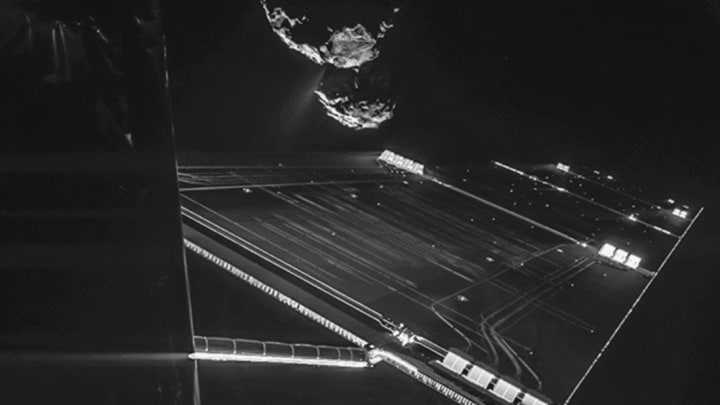Earlier today, as part of its Rosetta mission, the European Space Agency landed its Philae probe on Comet 67P/Churyumov-Gerasimenko—the first time in history this feat has ever been achieved. But why land a probe on a comet?
The Rosetta spacecraft launched in March 2004 and began its 10-year journey across the solar system into deep space—more than five times the distance between the Earth and the Sun—to rendezvous with Comet 67P/Churyumov-Gerasimenko, which occurred on August 6, 2014. The lander deployed today contains 10 scientific instruments; its batteries, which will drain after 64 hours, will be recharged by solar panels, allowing for one hour of exploration every two days. While the probe is exploring, the Rosetta spacecraft will continue to orbit the comet’s nucleus, following the celestial body on its path around the Sun (another historical first). The mission concludes in December 2015.
One of Rosetta’s goals is simply to observe a comet up close. “We have only observed comets from afar,” Joel W. Parker, a planetary scientist at the Southwest Research Institute in Boulder, Colorado, and the deputy principal investigator for an ultraviolet spectrograph instrument on the Rosetta spacecraft, told the New York Times. “Even the previous spacecraft flybys have been brief and could only study the comet by what they saw remotely. It is like the difference between what you can learn taking pictures from an airplane versus a geologist digging directly into the ground.” Scientists will also look at what happens to a frozen comet when it encounters the warmth of the Sun.
But the mission’s name holds some clues to its primary purpose: The Rosetta Stone, which helped us decipher hieroglyphics, and thereby understand the civilization in Ancient Egypt. The Rosetta spacecraft will help scientists understand comets, the oldest and most primitive bodies in the Solar System (at least, as far as we know). And by understanding comets, scientists hope to find out a little bit more about how our Solar System and its planets came to be. From the website:
Rosetta's prime objective is to help understand the origin and evolution of the Solar System. The comet’s composition reflects the composition of the pre-solar nebula out of which the Sun and the planets of the Solar System formed, more than 4.6 billion years ago. Therefore, an in-depth analysis of comet 67P/Churyumov-Gerasimenko by Rosetta and its lander will provide essential information to understand how the Solar System formed. There is convincing evidence that comets played a key role in the evolution of the planets, because cometary impacts are known to have been much more common in the early Solar System than today. ... Previous studies by ESA’s Giotto spacecraft and ground-based observatories have shown that comets contain complex organic molecules. These are compounds that are rich in carbon, hydrogen, oxygen, and nitrogen. Intriguingly, these are the elements that make up nucleic acids and amino acids, essential ingredients for life as we know it.
With this mission, scientists hope to determine whether life on Earth began with the help of a comet impact (or “comet seeding”). And even if Rosetta doesn't provide an answer, it will still provide scientists with a lot to study. You can follow the progress of the mission here, and keep up with the Philae probe's activities on the comet's surface here.
Touchdown! My new address: 67P! #CometLanding
— Philae Lander (@Philae2014) November 12, 2014
